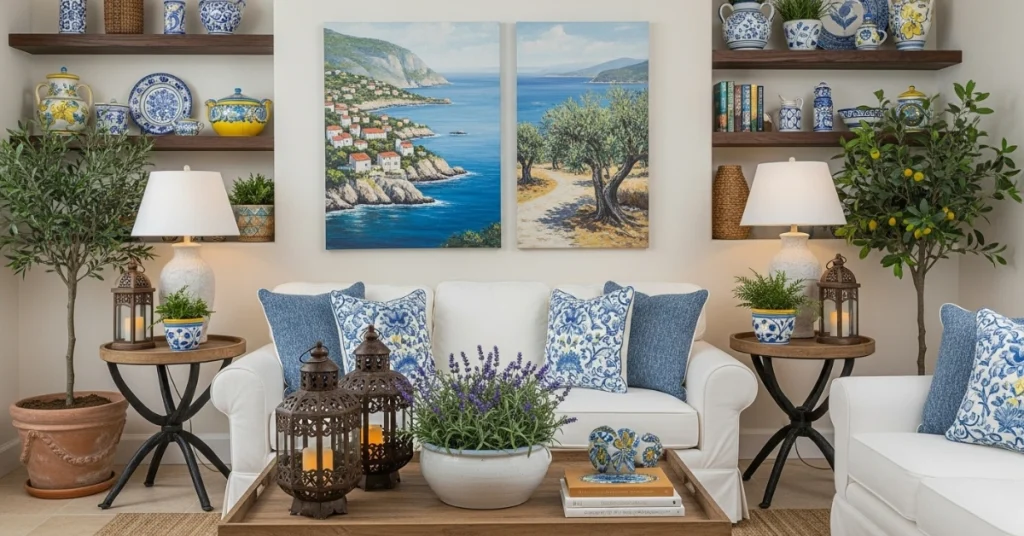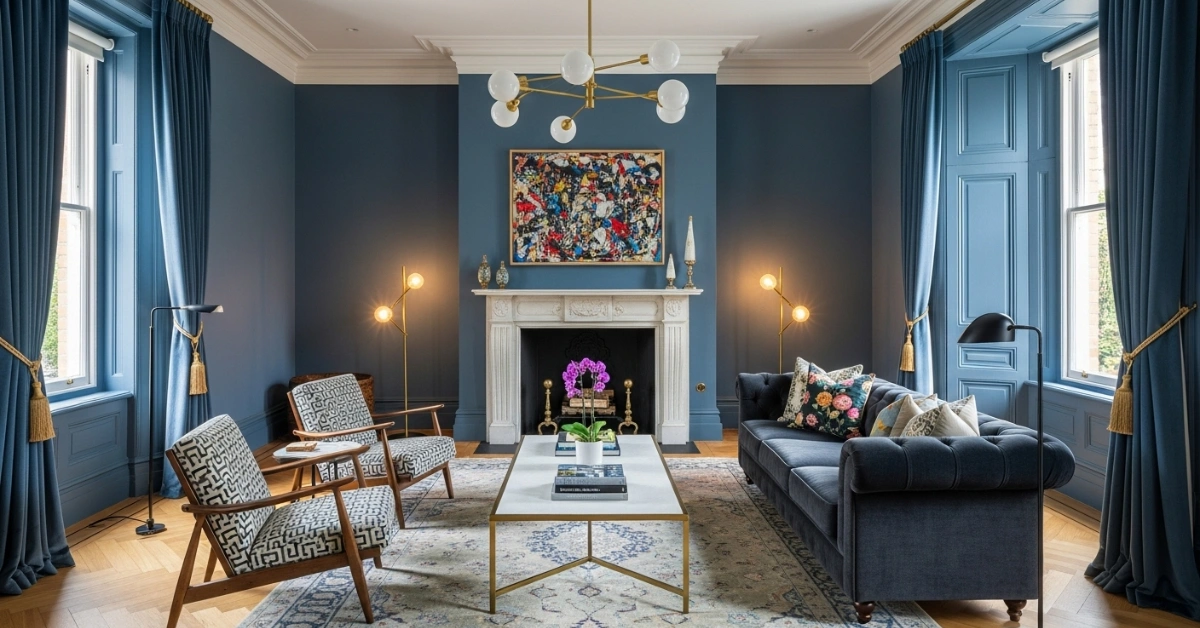Create a Cozy Mediterranean Living Room in 5 Steps

Imagine stepping into a living room that instantly transports you to a sun-drenched villa along the Amalfi Coast. Many homeowners crave a space that feels warm, inviting, and timeless, yet struggle to achieve that perfect balance of style and comfort. A Mediterranean living room could be the answer. This design style, inspired by the coastal regions of Spain, Italy, and Greece, blends rustic charm with vibrant elegance to create a space that’s both functional and breathtaking.
In this guide, we’ll walk you through everything you need to create a Mediterranean living room that reflects your personality while staying true to the style’s roots. From choosing the right colors and textures to incorporating authentic decor elements, you’ll find practical tips and inspiration to bring this timeless aesthetic to life. Let’s dive into the world of Mediterranean design and transform your living space into a cozy, coastal-inspired retreat.

What Defines a Mediterranean Living Room?
The Mediterranean living room style draws inspiration from the relaxed, sun-soaked lifestyles of Southern Europe. It emphasizes open spaces, natural materials, and a warm, earthy color palette. According to Architectural Digest, this aesthetic combines influences from Spanish, Italian, and Greek design traditions, creating a harmonious blend of rustic and refined elements (Source: Architectural Digest, 2023).

Key characteristics include:
- Natural materials: Think exposed wood beams, terracotta tiles, and wrought iron accents.
- Warm, earthy tones: Colors like terracotta, ochre, and sea blue dominate the palette.
- Open, airy layouts: Spaces feel inviting and connected to the outdoors.
- Textured finishes: Stucco walls, woven textiles, and handcrafted ceramics add depth.
Interior designer Maria Lopez, a Mediterranean design expert, explains, “This style is about creating a space that feels lived-in and soulful. It’s not just about aesthetics, it’s about evoking a sense of warmth and connection to nature.” Whether you live by the coast or in a bustling city, these elements can make your living room feel like a Mediterranean escape.
Choosing the Perfect Color Palette
Color sets the tone for any Mediterranean living room. The goal is to mimic the hues of the Mediterranean landscape—think sun-baked earth, azure seas, and golden sunlight.
Primary Colors to Embrace
- Terracotta and Ochre: These warm, earthy tones create a cozy foundation. Use them on walls or through accent pieces like rugs and cushions.
- Sea Blue and Turquoise: Inspired by the Mediterranean Sea, these shades add a refreshing pop of color. Consider a blue accent wall or throw pillows.
- Cream and White: Light neutrals keep the space airy and bright, reflecting the region’s abundant sunlight.

Accent Colors for Depth
Incorporate subtle accents like olive green, soft lavender, or mustard yellow to add personality. For example, a mustard yellow vase or olive green curtains can tie the room together without overwhelming the space.
Practical Tip: Balance Warm and Cool Tones
To avoid a flat look, balance warm and cool tones. For instance, pair a terracotta rug with white walls and blue cushions. Interior designer Elena Rossi suggests, “Use a 60-30-10 rule: 60% neutral tones, 30% earthy hues, and 10% bold accents for a cohesive Mediterranean vibe.”

In my own home, I painted one wall a soft terracotta shade and kept the others white. The contrast made the room feel warm yet spacious, and a few turquoise throw pillows added a coastal touch. Experiment with samples before committing to a color scheme to ensure it suits your lighting and space.
Selecting Furniture for a Mediterranean Living Room
Furniture in a Mediterranean living room should feel sturdy, timeless, and slightly rustic. Opt for pieces that look handcrafted or weathered, as they add character and authenticity.
Key Furniture Pieces
- Sofas and Armchairs: Choose low-profile sofas with neutral upholstery in linen or cotton. Add colorful throw blankets for a pop of Mediterranean flair.
- Wooden Coffee Tables: A distressed wooden table with carved details screams Mediterranean charm. Look for reclaimed wood for an eco-friendly touch.
- Wrought Iron Accents: Incorporate iron-framed chairs or side tables for a touch of Old-World elegance.

Layout Tips for an Airy Feel
Arrange furniture to promote conversation and openness. Place a sofa against a wall to free up floor space, and add a pair of armchairs opposite it. A large coffee table in the center anchors the room. If possible, position furniture near windows to maximize natural light, a hallmark of Mediterranean design.
Real-World Example
In a recent project, a client transformed their small living room by swapping a bulky sectional for a sleek linen sofa and two wrought iron armchairs. The result was a more open, inviting space that felt straight out of a Greek villa.
| Furniture Type | Material | Style Tip |
|---|---|---|
| Sofa | Linen or Cotton | Choose neutral tones; add colorful throws |
| Coffee Table | Reclaimed Wood | Opt for distressed or carved designs |
| Accent Chairs | Wrought Iron | Pair with cushioned seats for comfort |
Textures and Materials: The Heart of Mediterranean Style
Textures are the soul of a Mediterranean living room. They add depth and warmth, making the space feel lived-in and authentic.
Essential Materials
- Terracotta: Use terracotta tiles for flooring or as decorative accents like vases or planters.
- Stucco or Plaster Walls: These textured walls mimic the look of Mediterranean villas. A faux stucco finish is a budget-friendly alternative.
- Woven Textiles: Incorporate woven rugs, tapestries, or cushions in earthy tones or intricate patterns.
- Wood and Stone: Exposed wooden beams or stone accents (like a fireplace surround) add rustic charm.

How to Layer Textures
Start with a textured base, like a stucco wall or terracotta floor. Add a woven rug, then layer in soft textiles like linen curtains and cotton throws. Finish with hard accents, such as ceramic vases or wrought iron lanterns. Interior designer Luca Bianchi advises, “Don’t be afraid to mix textures, it’s the contrast between rough and soft that makes the style so inviting.”

For example, in a friend’s living room, we paired a rough-hewn wooden coffee table with a plush linen sofa and a woven jute rug. The combination felt cozy yet sophisticated, perfectly capturing the Mediterranean aesthetic.
Decor Elements to Elevate Your Space
Decor is where you can infuse personality into your Mediterranean living room. Focus on pieces that feel handcrafted and inspired by nature.
Must-Have Decor Items
- Ceramic Pottery: Hand-painted ceramics in blues, yellows, or whites add an artisanal touch. Display them on shelves or as table centerpieces.
- Wrought Iron Lanterns: These add a warm, ambient glow. Place them on side tables or hang them for a dramatic effect.
- Wall Art: Choose pieces inspired by Mediterranean landscapes, such as seascapes or olive grove paintings.
- Plants: Potted olive trees, lavender, or citrus plants bring the outdoors in, enhancing the coastal vibe.

Budget-Friendly Decor Tips
- DIY Pottery: Visit a local ceramics studio to create your own Mediterranean-inspired vases.
- Thrifted Finds: Look for wrought iron pieces or distressed frames at thrift stores to save money.
- Natural Elements: Collect seashells or driftwood from a beach trip to use as free, authentic decor.

Interior designer Sofia Conti shares, “Small details, like a hand-painted ceramic bowl or a woven basket, can make a big impact. They tell a story and make the space feel personal.”
Lighting: Creating a Warm, Inviting Glow
Lighting in a Mediterranean living room should feel soft and natural, mimicking the glow of a coastal sunset.
Types of Lighting to Use
- Chandeliers: A wrought iron or wooden chandelier adds elegance. Look for designs with candle-like bulbs for authenticity.
- Wall Sconces: Install sconces with warm-toned bulbs to create a cozy ambiance.
- Table and Floor Lamps: Choose lamps with ceramic or woven bases to tie in the Mediterranean theme.

Practical Lighting Tips
- Use dimmable lights to adjust the mood for different occasions.
- Place lamps strategically to highlight architectural features, like exposed beams or textured walls.
- Incorporate natural light by using sheer curtains that let sunlight filter through softly.

In my own living room, I installed a wrought iron chandelier and paired it with two ceramic table lamps. The warm glow transformed the space into a cozy retreat, perfect for evening gatherings.
Incorporating Architectural Details
Mediterranean living rooms often feature architectural elements that add character and authenticity.
Key Architectural Features
- Exposed Beams: Wooden beams on the ceiling create a rustic, farmhouse-like feel.
- Arched Windows or Doorways: Arches are a hallmark of Mediterranean architecture. If structural changes aren’t possible, use arched mirrors or wall art to mimic the look.
- Tiled Fireplaces: A fireplace with colorful, hand-painted tiles adds a focal point.

Budget-Friendly Alternatives
If renovating isn’t an option, consider faux beams made from lightweight materials or peel-and-stick tiles for a fireplace surround. These small changes can make a big impact without breaking the bank.
According to House Beautiful, incorporating even one architectural element, like an arched mirror, can elevate the Mediterranean aesthetic significantly (Source: House Beautiful, 2024).

Common Mistakes to Avoid
While designing a Mediterranean living room, it’s easy to make mistakes that disrupt the style’s harmony.
Mistakes and How to Fix Them
- Overloading with Color: Too many bold colors can feel chaotic. Stick to a balanced palette with one or two accent hues.
- Ignoring Textures: A flat, textureless room lacks depth. Layer woven rugs, linen cushions, and ceramic decor for richness.
- Choosing Modern Furniture: Sleek, minimalist furniture clashes with the rustic vibe. Opt for distressed or handcrafted pieces instead.
Interior designer Marco Greco warns, “The biggest mistake is trying to make the space too polished. Mediterranean style thrives on imperfection, embrace the rustic, lived-in look.”
Bringing It All Together: A Sample Design Plan
To help you visualize, here’s a sample design plan for a Mediterranean living room:
- Walls: Paint three walls cream and one accent wall terracotta.
- Flooring: Install terracotta tiles or a woven jute rug.
- Furniture: Place a linen sofa, two wrought iron armchairs, and a distressed wooden coffee table in a U-shaped layout.
- Decor: Add a ceramic vase, a wrought iron lantern, and a potted olive tree. Hang a seascape painting above the sofa.
- Lighting: Install a wrought iron chandelier and two ceramic table lamps.

This setup creates a warm, inviting space that’s both functional and stylish. Adjust the plan to suit your room’s size and budget.
Conclusion: Create Your Dream Mediterranean Living Room
A Mediterranean living room is more than just a design choice, it’s a lifestyle that celebrates warmth, nature, and timeless beauty. By blending earthy colors, natural textures, and rustic furniture, you can create a space that feels like a coastal escape, no matter where you live. Whether you’re starting from scratch or refreshing an existing room, these tips will help you craft a living space that’s both stunning and functional.
Ready to transform your home? Start by choosing one element perhaps a terracotta accent wall or a wrought iron lantern and build from there. Share your Mediterranean living room journey with us in the comments, or contact a local interior designer to bring your vision to life. Your dream space is just a few steps away!






